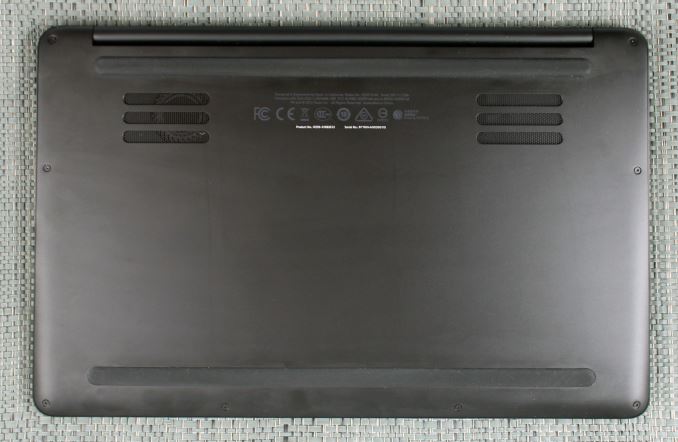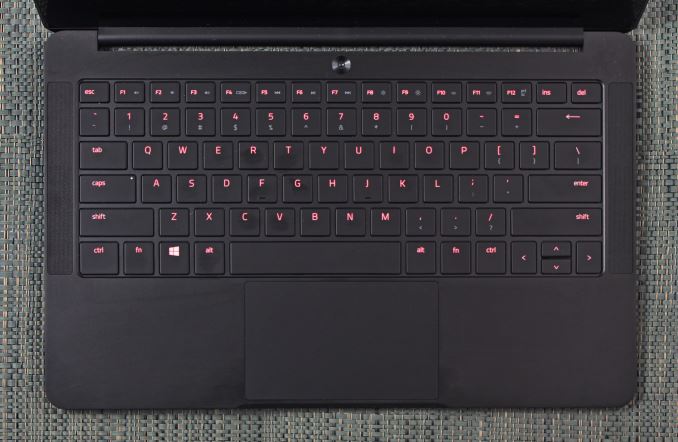The Razer Blade Stealth Review: Razer Takes On The Ultrabook
by Brett Howse on March 29, 2016 8:00 AM EST- Posted in
- Laptops
- Razer
- Skylake
- Razer Blade Stealth
- eGFX
- Razer Core
- Skylake-U
Design
From a distance, you would be hard pressed to tell the Razer Blade Stealth apart from the Razer Blade 14, if not for the fact that it’s a bit smaller. The Stealth is made out of the same CNC aluminum shell, with a matte black finish. The finish looks great, but it’s a bit of a fingerprint magnet, so keep a cloth handy. The top of the lid has Razer logo, which is really the one thing that moves away from the subtle look that the rest of the laptop has. With the matte black finish, and clean lines, the Stealth is as elegant as any Ultrabook around.
The left side has the Thunderbotl 3-enabled USB-C port for charging and docking, as well as a single USB 3.0 port and 3.5mm jack. The right side has a full-size HDMI port and the other USB 3.0 port. Other than those, the Stealth is devoid of openings or buttons on the outside.
It’s not too often we give much time to the underside of a notebook, but Razer is one of the few companies to do this right. The cooling intakes are found here, as well as some extremely sticky feet which run the entire width of the laptop. This gives the Stealth a very solid posture when sitting on a desk, and I know this is hard to believe, but that’s not always the case with every laptop.
Razer’s unique cooling solution puts the cooling exhaust vents in the hinge between the display and back of the laptop, which is the same cooling solution they offer on the larger Blade 14. This hides the exhaust vents for a cleaner look, although it can cause some heat build-up in the hinge itself. This isn’t as big of an issue in the Stealth as it is in the Blade 14, due to the much lower thermal output of the Stealth.
Opening the lid, you see a couple of things right off the bat. First, Razer has kept the same deck mounted speakers as the Blade 14, which is nice to see since most Ultrabooks end up putting the speakers on the bottom. You also see that the display bezels are quite large, and Razer could have easily put a 13.3-inch panel into this notebook. Thin bezels seem to be something only Dell and Microsoft want to offer. The larger bezels do allow Razer to fit a good size keyboard into the chassis, in addition to the side mounted speakers, and there is also plenty of room for the generous trackpad.
The keyboard in the Razer Blade Stealth is a typical Ultrabook keyboard, with shallow travel due to the limited thickness of the device. Anyone who is going to be writing a novel is going to want something with a bit more travel. It’s a common complaint but I understand there is only so much travel available when trying to keep the device as thin and light as possible. The resistance on the keys is decent, which helps a bit. Surprisingly, and once again likely due to Razer wanting to expand their customer base, the Razer font which is used on their other products is not on the Stealth. Instead you get a much more traditional look to the key faces. Razer’s trackpad is quite good, which a nice large smooth surface and accurate responses. The trackpad leverages Synaptics software for multi-touch.
Likely the most interesting aspect of the keyboard though is the backlighting. The Stealth is the first laptop to offer per-key RGB backlighting, and Razer uses their Chroma branding to distinguish this. This means you can change the key lighting to any of 16.7 million colors (red green blue, 256 levels per color) and the Razer Synapse software gives full customizability to this. There are several patterns you can choose from, including spectrum cycling to shift among all of the colors, breathing, wave, ripple, or just static. It also lets Razer do some funky things like being able to change the function key lighting when the function key is pressed. It’s a great effect, and being able to change the backlighting lets you customize the laptop to your own tastes, and considering the pricing on the laptop it’s a nice addition.
The design of the Stealth is pure Razer, and they’ve done a great job taking the look and feel of their larger laptops and scaling it down to the Ultrabook form factor. The CNC aluminum shell is solid, and the build quality is very nice. The entire package is just 13.1 mm or 0.52” thick, and weighs 1.25 kg or 2.75 lbs.














66 Comments
View All Comments
ImSpartacus - Tuesday, March 29, 2016 - link
The battery life is disappointing, but at least seems to be alright otherwise.The keyboard appears like overkill, but at least you can presumably switch to a clean white light.
Keao - Tuesday, March 29, 2016 - link
It is overkill if you just want an ordinary ultrabook indeed. Needs to see if the glowing razer logo on the back can be deactivated too. (You can switch to plain white for sure given it works like the blackwidow chroma that I have)Battery life is really not great but is OK for the kind of processor they have isn't it? What's putting me a lil' off is the fact that to make it a gaming machine you do need to shell out at least some 750 additional bucks. Sure the external case will be re-used supposedly but I'm unsure about the future of this solution (Can evolve quite fast with a new Thunderbolt version and/or replacement of the PCI-e interface?)
zeroqw - Tuesday, March 29, 2016 - link
"Battery life is really not great but is OK for the kind of processor they have isn't it?" nope.. there are quite similar ultrabooks with at least 50% more battery life.Razer put a small battery in the laptop and if you add the backlit keyboard+glowing razer logo to the equation it just makes it even worse. Too bad because I love the design but the battery life is a deal breaker for me.
Duraz0rz - Tuesday, March 29, 2016 - link
You can turn off the logo LED thru Synapse.TheinsanegamerN - Tuesday, March 29, 2016 - link
Wont fix the battery being too small.DanNeely - Tuesday, March 29, 2016 - link
The battery size isn't the main problem; it's in the same general class as other 13" ultrabooks. The problem is that the laptop's efficiency is bad; if they were able to match their competitions efficiency they'd pick up an extra hour or two bringing the QHD model up to the average for a laptop of its size; and leaving the 4k one with only the penalty related to its ultra high res display (both more GPU work to drive it, and more transistors in the panel blocking a larger amount of the backlight).ImSpartacus - Tuesday, March 29, 2016 - link
I think Razer is struggling with both the pixel race and needing to justify the existence of Core.Honestly, a 768p display would be perfect for a 12.5" laptop (maybe 900p for a buy-up). But then you could say that Razer should've made the Core a smidge thicker and put a modest dGPU in there for gaming.
Spunjji - Wednesday, March 30, 2016 - link
Couldn't disagree more about the display. The sooner we get rid of low-DPI panels and the software ecosystem is forced to accept their existence, the better. The problem here isn't the display, it's a lack of engineering experience regarding power efficiency at Razer.BrokenCrayons - Wednesday, March 30, 2016 - link
I disagree with that. Higher resolution displays, while nice looking, offer little to no added functionality after reaching the point where it becomes necessary to scale the interface in order to retain visibility of objects displayed in it. At this point, they're part of the specifications for the sake of specifications war that's vital for product differentiation and marketing, but that's where it ends. Sacrificing capability as in the case of battery life to achieve a pointlessly high resolution shows particularly poor engineering. An Intel GPU in a 12.5 inch laptop display that is unable to drive games at much lower resolutions should be paired with a 1366x768 panel of decent quality with good viewing angles. Anything more than that won't benefit the end user regardless of how much they think they need more pixels.JoeyJoJo123 - Wednesday, March 30, 2016 - link
>should be paired with a 1366x768 panel of decent quality with good viewing angles.Except that's the thing. In the year 2016 there is no such thing as a 1366x768 panel of anything remotely decent quality. Panels of this size are just churned out by the factory for extremely low cost/low margin devices such as $300 laptops at Walmart.
If you're paying ~$1500 for a premium laptop, you should expect an arguably premium display. If you can't play the game at 2560x1440, then run the game at reduced settings, and if that's not enough, begin lowering the resolution, too.
Paying ~$1500 for a premium laptop also comes with the inherent notion you're paying for premium battery life, but you're not getting that here, either.
Replacing a good screen on a laptop with a bad battery leaves you with a laptop with bad screen and bad battery and now you have an even worse value proposition than before.